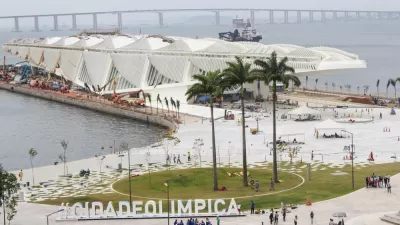For China, the Olympics represent a struggle between letting people in and controlling what they see and do. This is a problem, writes Andrew Yang, that implicates the Olympics-related architecture in a bad way.
"For China, the Olympics has been both a galvanizing force and an exercise in pride, partly deserved, partly not."
"Recently, however, the exercise has not gone entirely according to plan. In spite of their inevitability, the mass protests in Tibet, Xinjiang (the Muslim part of Western China), and Mongolia still caught the government off their usually rigid guard. Even more unpredictable has been the tumultuous time the government has had trying to control the coverage of these events. And when widespread public sympathy during the Sichuan Earthquake led to a huge demand for news, the state could no longer reasonably control the local and foreign media."
"The Olympics have laid bare the illogic behind the government's approach. It invites the world in, but then restricts entry for fear that a bunch of Teva-wearing hippies might show up and disrupt the games. Of course there will be controversy-China is a totalitarian state, after all-but in courting the public stage, China is also courting widespread scrutiny of its atrocious human rights record."
"Above all, what I blame most on the Olympics is how it implicates architecture in the fabrication of this whole spectacle, and even uses it to mask real urban problems confronting Beijing. Without a doubt, OMA's CCTV and Herzog and de Meuron's Olympic Stadium will remain masterpieces in the landscape of the city. But within its Soviet-inspired planning fabric, with its concentric highways lapping outward from the hub of the Forbidden City, huge monolithic-style building threatens to add to the isolation of Beijing's vast alienating stretches. Anyone who has traveled through rush hour there, where it routinely takes 60 minutes to budge five miles, will have contemplated the poor planning implicated by this level of congestion."
FULL STORY: Protest: China's Olympic Syndrome

Study: Maui’s Plan to Convert Vacation Rentals to Long-Term Housing Could Cause Nearly $1 Billion Economic Loss
The plan would reduce visitor accommodation by 25,% resulting in 1,900 jobs lost.

North Texas Transit Leaders Tout Benefits of TOD for Growing Region
At a summit focused on transit-oriented development, policymakers discussed how North Texas’ expanded light rail system can serve as a tool for economic growth.

Why Should We Subsidize Public Transportation?
Many public transit agencies face financial stress due to rising costs, declining fare revenue, and declining subsidies. Transit advocates must provide a strong business case for increasing public transit funding.

How to Make US Trains Faster
Changes to boarding platforms and a switch to electric trains could improve U.S. passenger rail service without the added cost of high-speed rail.

Columbia’s Revitalized ‘Loop’ Is a Hub for Local Entrepreneurs
A focus on small businesses is helping a commercial corridor in Columbia, Missouri thrive.

Invasive Insect Threatens Minnesota’s Ash Forests
The Emerald Ash Borer is a rapidly spreading invasive pest threatening Minnesota’s ash trees, and homeowners are encouraged to plant diverse replacement species, avoid moving ash firewood, and monitor for signs of infestation.
Urban Design for Planners 1: Software Tools
This six-course series explores essential urban design concepts using open source software and equips planners with the tools they need to participate fully in the urban design process.
Planning for Universal Design
Learn the tools for implementing Universal Design in planning regulations.
City of Santa Clarita
Ascent Environmental
Institute for Housing and Urban Development Studies (IHS)
City of Grandview
Harvard GSD Executive Education
Toledo-Lucas County Plan Commissions
Salt Lake City
NYU Wagner Graduate School of Public Service



























